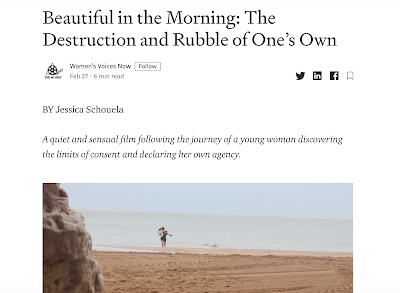A short piece I wrote on my childhood friend Flavia Casa's first feature film!
Publisher:
The WVoice is an online publication disseminated by Women’s Voices Now (WVN). The multifold mission of The WVoice is: to create a written and (audio)visual body of works that documents international women’s stories and issues, to educate and foster cross-cultural and societal connections, and to promote women’s rights activists and advocacy groups.
https://medium.com/the-wvoice/beautiful-in-the-morning-the-destruction-and-rubble-of-ones-own-d6cd0f1f6600
Words, images and documents by or collected by Jessica Schouela
Thursday, 27 February 2020
Wednesday, 26 February 2020
Tuesday, 25 February 2020
Monday, 24 February 2020
Jun'ichirō Tanizaki, In Praise of Shadows (1933)
I've beed reading the beautiful edition of In Praise of Shadows (Vintage), which includes gorgeously printed interspersed images of Japanese art forms (painting, calligraphy, textiles, etc.) and architecture— the images are often all-over compositions and/or close up details—to accompany the 1933 text on Japanese aesthetics.
This passage on the ways in which certain media, invented by the West who set its design conditions as well as uses, is faithful to Western visual culture and identity without sufficient consideration or malleability to represent Japanese culture with the same degree of aesthetic rendition. It is perhaps a failure of translation or flexibility to apply outside the source of invention on equal levels. Rather, Tanizaki's point is that as a result of cross-cultural interaction, the Japanese may never have invented certain technologies that they adopted from the west—he gives the example of the fountain pen, which does not have a tufted end like the Japanese writing brush, but may have, had its inventors not been Western—but had they, these inventions would have been designed and produced with different sensibilities, for purposes that reflected specifically Japanese uses.
This passage on the ways in which certain media, invented by the West who set its design conditions as well as uses, is faithful to Western visual culture and identity without sufficient consideration or malleability to represent Japanese culture with the same degree of aesthetic rendition. It is perhaps a failure of translation or flexibility to apply outside the source of invention on equal levels. Rather, Tanizaki's point is that as a result of cross-cultural interaction, the Japanese may never have invented certain technologies that they adopted from the west—he gives the example of the fountain pen, which does not have a tufted end like the Japanese writing brush, but may have, had its inventors not been Western—but had they, these inventions would have been designed and produced with different sensibilities, for purposes that reflected specifically Japanese uses.
This passage speaks to me for many reasons. To name a couple: (1) for its attention to the "nuances of shading and coloration" in photography, which would have been designed to better represent a different shade of skin and a different landscape; and (2) for its appreciation of atmosphere as a critical concern for the production of Japanese music.
Friday, 21 February 2020
Day Sleeper, Dorothea Lange and Sam Contis (at LRB)
Really lovely to hear photographer Sam Contis discuss her new book called Day Sleeper of selected photographs by Dorothea Lange from the Oakland Museum of California Archive.
A quote by Sam Contis from Day Sleeper:
Photographs by Lange in the book:
On Sam Contis's book of photographs, Deep Springs. Photographs from Deep Springs:
Tuesday, 18 February 2020
Sunday, 16 February 2020
Tuesday, 4 February 2020
PhD - a Dr!
The best news: my PhD thesis corrections have been approved and I am officially Dr Jessica Schouela! Feels completely surreal and wonderful after four long years of hard work and dealing with life's curve balls, some immensely challenging and some truly magical!
Sunday, 2 February 2020
The Strangeness of Grief by V. S. Naipaul
Recent essay in The New Yorker on the mourning of family members and beloved cats...
"The vase stayed with me for years. I drew it often, and sometimes attempted—more difficult, this—to render it in watercolor. Because of this detached study, it became in the end only an object, without associations; the grief of which it once spoke so directly was rubbed away, like the grief itself, though that stayed with me so completely and for so long, waiting to be recalled, that I was able, some years later, during the writing of my first novel, a comedy, very light (but full of anxiety for me), to transfer much of the episode (beginning with the telegram) to that quite different book, in a concealment and sublimation of grief."
"We are never finished with grief. It is part of the fabric of living. It is always waiting to happen. Love makes memories and life precious; the grief that comes to us is proportionate to that love and is inescapable."
"The vase stayed with me for years. I drew it often, and sometimes attempted—more difficult, this—to render it in watercolor. Because of this detached study, it became in the end only an object, without associations; the grief of which it once spoke so directly was rubbed away, like the grief itself, though that stayed with me so completely and for so long, waiting to be recalled, that I was able, some years later, during the writing of my first novel, a comedy, very light (but full of anxiety for me), to transfer much of the episode (beginning with the telegram) to that quite different book, in a concealment and sublimation of grief."
"We are never finished with grief. It is part of the fabric of living. It is always waiting to happen. Love makes memories and life precious; the grief that comes to us is proportionate to that love and is inescapable."
Subscribe to:
Comments (Atom)
































